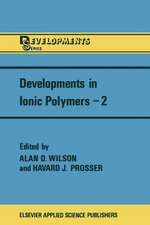Strength and Toughness of Materials
Autor Toshiro Kobayashien Limba Engleză Paperback – 14 oct 2012
| Toate formatele și edițiile | Preț | Express |
|---|---|---|
| Paperback (1) | 640.06 lei 6-8 săpt. | |
| Springer – 14 oct 2012 | 640.06 lei 6-8 săpt. | |
| Hardback (1) | 646.30 lei 6-8 săpt. | |
| Springer – 4 mar 2004 | 646.30 lei 6-8 săpt. |
Preț: 640.06 lei
Preț vechi: 753.01 lei
-15% Nou
Puncte Express: 960
Preț estimativ în valută:
122.47€ • 127.88$ • 101.13£
122.47€ • 127.88$ • 101.13£
Carte tipărită la comandă
Livrare economică 15-29 aprilie
Preluare comenzi: 021 569.72.76
Specificații
ISBN-13: 9784431679738
ISBN-10: 4431679731
Pagini: 288
Ilustrații: X, 275 p.
Dimensiuni: 155 x 235 x 15 mm
Greutate: 0.41 kg
Ediția:Softcover reprint of the original 1st ed. 2004
Editura: Springer
Colecția Springer
Locul publicării:Tokyo, Japan
ISBN-10: 4431679731
Pagini: 288
Ilustrații: X, 275 p.
Dimensiuni: 155 x 235 x 15 mm
Greutate: 0.41 kg
Ediția:Softcover reprint of the original 1st ed. 2004
Editura: Springer
Colecția Springer
Locul publicării:Tokyo, Japan
Public țintă
ResearchCuprins
1 Introduction.- 1.1 Development of Materials and their Characteristics.- 1.2 Fracture and Damage.- 1.3 Rise of Fracture Mechanics and Strengthening and Toughening.- 2 Basic Concepts of Fracture Mechanics.- 2.1 Fracture Toughness.- 2.2 Elastic-Plastic Fracture Mechanics.- 2.3 Measurement of Fracture Toughness.- 2.4 Application of Fracture Toughness.- 3 Principles of Strength and Toughness.- 3.1 Classical Fracture Theory.- 3.2 Microstructure and Fracture Mechanism.- 3.3 Inexpensive Toughness Evaluation Method-Instrumented Charpy Impact Test.- 3.4 Specimen Size Effect and J-Q Theory.- 4 Steels.- 4.1 Solid Phase Transformation in Steels.- 4.2 Correlations among Strength, Fracture and Microstructures.- 4.3 Strengthening and Toughening of Practical Steels.- 4.4 Degradation in Steels.- 4.5 Strength and Fracture of Carburized Steel.- 5 Ductile Cast Iron.- 5.1 Fracture Mechanism in Ductile Cast Iron.- 5.2 Evaluation of Fracture Toughness.- 5.3 Influence of Microstructure on Fracture Toughness.- 5.4 Strengthening and Toughening of Ductile Cast Iron.- 5.5 Fatigue Characteristics of Ductile Cast Iron.- 6 Wrought Aluminum Alloys.- 6.1 Aluminum Alloys and their Features at Deformation.- 6.2 Microstructure and the Fracture Mechanism.- 6.3 Ductile Fracture Details.- 6.4 Testing Methods for Fracture Toughness of Aluminum Alloys—R Curves Method.- 6.5 Toughness of Aluminum Alloys and the Metallurgical Factors.- 7 Cast Aluminum Alloys.- 7.1 Aluminum Alloy Casting and Solidification.- 7.2 Solidification Microstructure and Fracture Toughness.- 7.3 Fatigue Characteristics.- 8 Metal Matrix Composites.- 8.1 Key Points of Composite Materials.- 8.2 General Deformation and Fracture Mode.- 8.3 Improvement of Fracture Characteristics by Controlling MMC Microstructure.- 8.4 Fatigue FractureBehavior.- 9 Titanium Alloys.- 9.1 Mechanical Characteristics of Titanium Alloys.- 9.2 Influence of Microstructure on Fracture Toughness.- 9.3 Micromechanism of Crack Initiation and Crack Propagation.- 9.4 Embrittlement and Strengthening of Titanium Alloys by Hydrogen.- 9.5 Strain Induced Transformation and Mechanical Properties.- 10 Intermetallic Compounds.- 10.1 Application of Fracture Mechanics Testing.- 10.2 Influence of Alloying.- 10.3 Influence of Microstructure Control.- 10.4 Environmental Embrittlement.- 11 Ceramics.- 11.1 Characteristics of Strength and Toughness in Ceramics.- 11.2 Evaluation Methods for Toughness.- 12 Polymers.- 12.1 Characteristics and Deformation Mechanisms of Polymers.- 12.2 Mechanical Properties of Polymers.- SI Units and Conversion Table.
Caracteristici
Has a feather of interdisciplinary nature Fracture mechanics and microstructure relations are mainly described The title of this book has not often been found, but it is the most important theme in the fields of materials and mechanics


















